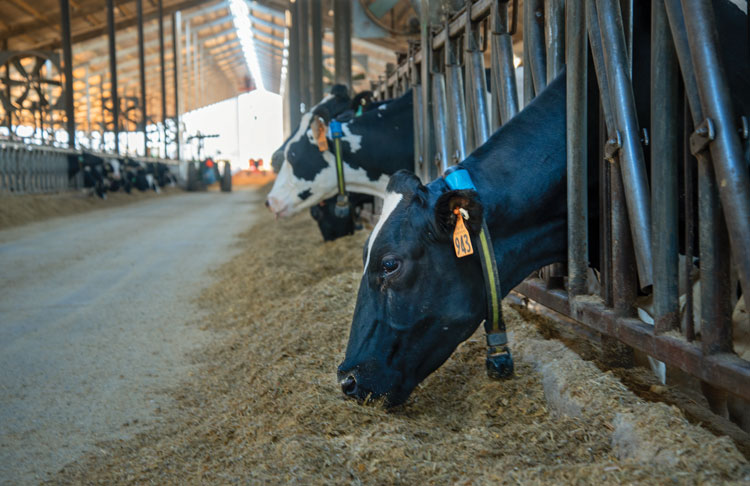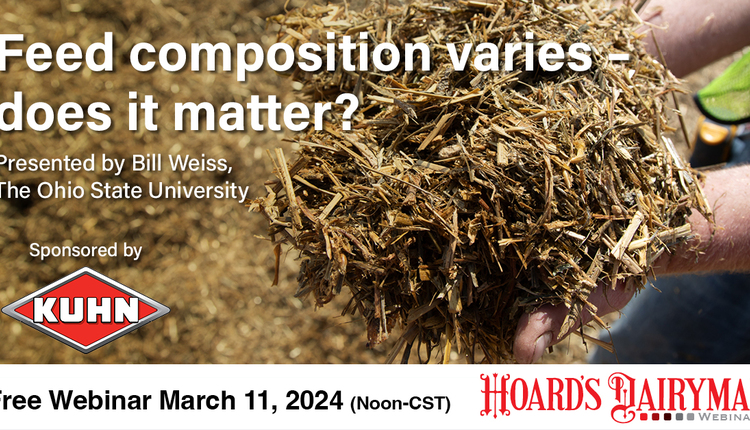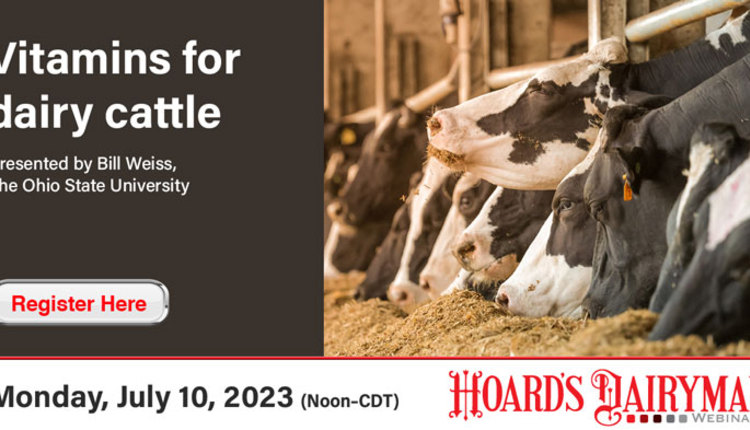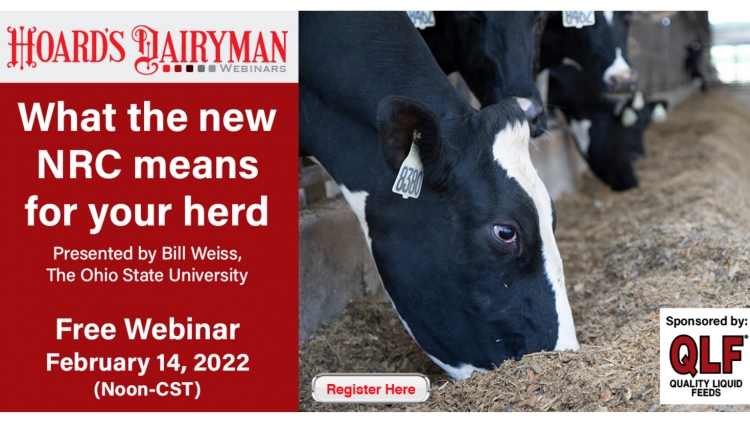The author is a professor emeritus in the animal science department at The Ohio State University.

A required nutrient must be supplied to cells for the cow to maintain normal health, produce milk, and reproduce. Just because a nutrient is required, though, does not mean that a specific requirement can be determined.
The 2021 National Academies of Sciences, Engineering, and Medicine (NASEM) committee, formerly known as the NRC, estimated requirements for the major minerals and a few trace minerals. However, dietary recommendations for iodine, manganese, selenium, and vitamins A, D, and E are called “adequate intakes” rather than requirements.
An adequate intake (AI) is the amount of the nutrient a cow should consume daily based on the limited data that was available to the NASEM committee. Adequate intake was used when a mineral or vitamin is essential and deficiency signs have been observed in cattle, but data were not sufficient to precisely define how much is needed.
Vitamin E deficiency signs have been observed in dairy cows, and several studies have shown that feeding about 1,000 international units (IU) of supplemental vitamin E per day to dry cows reduces prevalence of certain diseases in early lactation. Based on that research, the committee set the AI for dry cows at about 1,000 IU/day. However, 500 IU/day might be adequate, or 2,000 IU/day might be better, but based on available data, the committee only knew that 1,000 IU/day provided a benefit. For diet formulation, nutritionists should consider AI the same as a requirement.
Metabolic benefits
Another set of minerals and vitamins are metabolically essential but may or may not be dietary essential. Because these nutrients usually do not need to be in the diet, clinical signs of a deficiency in cattle have not been observed. These nutrients include biotin, choline, and chromium, among others. In the new NASEM book, rather than defining a requirement or AI for these nutrients, potential responses to greater intake of these nutrients are discussed.
Choline is an essential component in cell membranes. It is needed to export fat out of the liver, and it is a source of methyl groups, which are needed for numerous metabolic reactions. Choline is synthesized by the cow, so it does not need to be in the diet to prevent a clinical deficiency.
Several studies and two meta-analyses have shown benefits, though, when diets are supplemented with rumen-protected choline (it must be protected to have any effect). Based on those experiments, feeding rumen-protected choline at the typical inclusion rate (about 13 grams of actual choline) during late gestation and early lactation —most experiments start a few weeks prior to calving and stop at about 60 days in milk — is expected to increase daily milk yield 3 to 4 pounds, milkfat about 0.2 pounds, milk protein about 0.3 pounds, and dry matter intake about 1 to 1.5 pounds.
Data are less clear on health effects, but some studies have shown that supplementing rumen-protected choline results in fewer health problems during the transition period. The conclusion is that even though NASEM did not establish a requirement or AI for choline, it still is often a profitable addition to transition and early lactation diets.
Biotin is a B-vitamin and a co-factor for several important enzymes, including those involved with amino and fatty acid metabolism and glucose synthesis. It is also involved in gene regulation. Biotin must be absorbed by the small intestine, but because it is synthesized by rumen bacteria, it does not need to be in the diet to prevent clinical deficiencies.
Nonetheless, most studies have reported elevated milk and milk component yields when about 20 milligrams per day (mg/day) of biotin was supplemented to cows at various stages of lactation. Based on two meta-analyses, the average expected daily increase in milk, milkfat, and milk protein yields are about 3.5, 0.4, and 0.07 pounds, respectively. Dry matter intake is expected to go up about 1.3 pounds per day.
Biotin supplementation also often improves various measures of hoof health, including reduced white line disease, fewer sole lesions, and reduced clinical lameness. The mechanism for these responses is not clear.
Production responses to biotin often start within a few days of supplementation, but improvements in hoof health are not observed until several weeks or months of supplementation. To maximize benefits on hoof health, biotin should be supplemented continuously throughout lactation and the dry period. The NASEM committee did not estimate an AI or requirement for biotin because clinical deficiencies do not occur, but responses to supplementation are usually positive and profitable.
Possible positive effects
Although chromium is a dietary essential mineral, clinical deficiency signs have not been observed in cattle. This could mean that basal concentrations of chromium are adequate to meet requirements or that the clinical signs of deficiency are too subtle or generic to ascribe directly to chromium. We have poor information regarding intake of chromium from basal diets because accurately measuring chromium in feeds is extremely difficult and requires specialized equipment unavailable to most commercial testing labs.
Supplementing different sources of chromium to dairy cows has improved yields of milk and milk components and elevated feed intake. With supplemental chromium from various sources, the average daily increase in milk, milkfat, and milk proteins was about 3, 0.15, and 0.09 pounds, respectively.
A logical explanation for the production responses is the effect chromium has on insulin metabolism. Chromium is an essential component of a small compound found in some cells that elevates insulin sensitivity. In other words, less circulating insulin is needed. This can raise glucose synthesis by the liver and partition more nutrients to the mammary gland away from muscle and fat.
Most studies started supplementation in late gestation and stopped by two months of lactation. Whether chromium affects milk production later in lactation is unknown. Supplementation rates varied among studies, but most were between 4 and 10 mg/day. In the U.S., the maximum allowed supplementation rate is 0.5 parts per million (ppm) of chromium from chromium propionate.
Supplemental chromium also has improved some measures of immune function and has reduced incidence of some clinical diseases. Chromium often lowers circulating concentrations of cortisol, which could explain some of the immune responses. The mode of action on cortisol is unknown, but studies using cultured cells found that high amounts of chromium may inhibit synthesis of cortisol by the adrenal gland. This suggest that supplemental chromium may not be fixing a chromium deficiency but rather having what is called supranutritional effects.
Limited data also suggests that supplemental chromium may help partially mitigate heat stress. As with choline and biotin, the NASEM committee did not determine a chromium requirement or AI, but supplemental chromium, especially during the transition period and early lactation, often elicits positive and profitable responses.
There are legitimate reasons requirements were not established for certain nutrients, even though supplementation of those nutrients often has positive effects. As with feed additives, nutritionists should evaluate experiments with these nutrients to determine whether they should be included in diets in individual farm situations.









